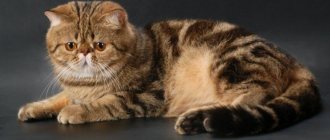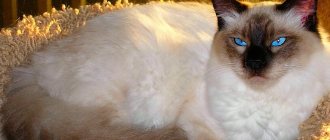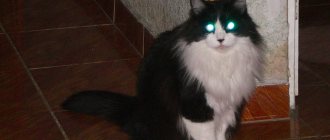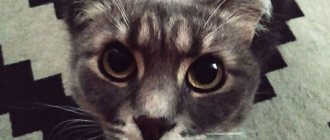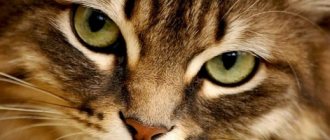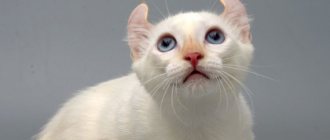A cat with eyes of different colors looks fascinating. Who would refuse such a pet, which arouses lasting interest and admiration among guests and acquaintances! People even start looking for a breed of cat with different eyes, not fully understanding the reason for such an unusual phenomenon.
White cat with different eyes
I hasten to disappoint - such a breed does not exist. The good news is that kittens with different eyes can be found in any cat breed that accepts solid white or tortoiseshell.
Tricolor cat with different eyes
Author of the article: Olga Shiltsova, practicing veterinarian, author of the books “Dachshund of Fate” and “Tails of Fortune”
How is it that a cat has different colored eyes?
Different eye colors have a scientific name - heterochromia. Heterochromia occurs not only in cats, but also in dogs, horses, and even in humans (although it is a very rare occurrence in humans).
Complete heterochromia is when each eye is colored differently, and partial heterochromia is when two colors are combined in the iris of the eye. Partial heterochromia is truly rare, but a cat’s completely different eyes won’t surprise anyone.
Partial heterochromia
Partial or sectoral heterochromia
With complete heterochromia, one eye will always be blue, and the other - any color: yellow, green, orange. The secret is that blue eyes in cats are not a color at all, but its absence. That is, the color is genetically determined, but something prevented the pigment from migrating into the iris.
Complete heterochromia in a white cat
The distribution of pigment occurs while the kitten is still in the mother's womb. It is impossible to influence this process, nor can it be predicted. Therefore, breeding a “breed of cats with different eyes” is simply impossible.
White cat with heterochromia
Why does heterogeneity regularly occur in certain breeds or breeding lines? It's all white's fault! The gene for white color (it is called W - white) does not carry information about color, but simply suppresses all other colors. A snow-white cat may well give birth to colored kittens if she is secretly not white, but red or black. This white gene disrupts the flow of pigment into one eye - or both, as it turns out. That is, some kittens will have green or yellow eyes, some will have blue eyes, and some will have different ones.
Eyes of different colors are often found in white cats and cats.
Burmilla
Graceful aristocrats. These cats have long or short haired silver coats and expressive eyes of emerald or amber color. The breed standard does not include a perfectly white color - often the muzzle, back and tail of these cats are slightly darker than the color of the body. But this in no way spoils the beautiful Burmilla, making her even more unusual and attractive.
No matter what breed a white cat is, it is always gorgeous. In many countries, snow purrs are a symbol of peace, love and light. If you are going to buy yourself a purring pet, think about its white color. Such a cat will not only become the keeper of the hearth, but also your most faithful and devoted friend!
Does this affect the pet's health?
Eye color does not affect a cat's vision in any way. But if different eyes appeared under the influence of a dominant white gene, the cat may have hearing problems. The fact is that the W gene inhibits the migration of melanoblast cells not only into the iris, but also into the inner ear, disrupting the development of this organ.
This cat may be deaf in her left ear.
This is why white cats sometimes suffer from congenital deafness. Most often, the problem concerns blue-eyed animals (the effect of the gene is most pronounced), but contrary to popular belief, a white cat with colored eyes can also be deaf. If one eye is colored and the other is blue, then the cat may be deaf on the side of the blue eye, but can hear normally in the other ear. In this case, the owner is unlikely to notice any problem, and the cat’s hearing can only be checked using special tests under anesthesia in a veterinary clinic.
Pure white Maine Coon with heterochromia - possible deafness in the right ear
Deaf cats must be strictly rejected and are not allowed for breeding - this applies to any breed. In addition, you should not cross two white, blue-eyed individuals with each other, even if both the cat and the cat hear perfectly.
Exotic
In many of their external characteristics, exotics are similar to the Persian cat, and this is not surprising, since these funny purrs with a “cute” expression on their faces are their direct descendants. The main distinguishing feature of the breed is their funny, slightly turned up snub nose. The snow color of the exotic is very rare and therefore very valuable. Their short fur, reaching no more than a couple of centimeters in length, is very soft and thick. It is difficult to find a calmer and more docile animal than this “plush” pussy.
Cat breeds with different eyes
So, there is no blue-eyed gene, no deafness gene, no different-eyed gene. Why does the Internet persistently offer some cat breeds as “different-eyed”? These are breeds where the snow-white color is:
- is the only valid one: kao-mani;
- very common: Turkish Angora;
- combined with colored spots: Turkish van.
Angora cat with different eyes
Turkish Van cat with heterochromia
Different eyes are often found in cat breeds for which white color is only an acceptable variety, and not the main breed characteristic. Breeders have a theory that to produce kittens with heterochromia, you need to cross white animals with bicolors.
Outbred black and white cat with different eyes
Bicolor color in Russian - two-color. Such animals are also called piebald: white spots alternate with colored areas. If there are a lot of white spots, then the cat may look completely white (a speck of color can be located on the tail or on the head). This white color is caused not by the W gene, but by the white piebald spotting gene - S (spot). The S gene also disrupts the migration of melanocytes to the fur and sometimes to the eyes, but does not cause deafness. Since the spots are characterized by asymmetry, it is not surprising if one eye is colored and the other is not.
It is the spotting gene S that is responsible for the color and heterochromia of the eyes in Turkish Vans, while in Kao Mani and Angora it is the dominant gene for white color W.
A Turkish Van cat with different eyes. The piebald S gene is responsible for color
There is another pattern: if a matched couple has a kitten (or several) with different eyes in their litter, then there is a high probability that in the next litters from these parents it will be possible to consistently produce kittens with heterochromia.
Thus, eyes of different colors can be found in cats of any breed, if white or spotted color is acceptable according to the standards - Cornish Rex, Sphynx, Maine Coon, Persian and exotic cats, British cats and many others.
White Cornish Rex with heterochromia
You should not discount ordinary mongrel cats - mestizos, in which heterochromia is also common. It must be said that a kitten with different eyes sharply increases the chances of finding a home - many are ready to take such an unusual pet, even if it is of “noble” blood. It is believed that cats with different eyes bring good luck to the owner and have strong magical powers. And even if you are far from esoteric, it is impossible to deny that cats with heterochromia look very impressive and mysterious.
Mongrel cat with different eyes
One of my friends even found a “bride” for his mongrel cat in the hope of getting an odd-eyed kitten. Unfortunately, the white Dobby (one eye is yellow, the other blue) and the white blue-eyed cat gave birth to kittens with the same yellow or blue eyes. Two of them were cream-colored, two were white - and both white kittens turned out to be deaf.
Mongrel cat with different eyes
Japanese Bobtail
A striking representative of tailless cat breeds. It can be either short-haired or long-haired. Pure white bobtails are extremely rare. The most common color is bicolor - a snow-white body with black or red spots at the base of the tail or on the head. Bobtails are very agile, intelligent, and easy to train, so if you wish, it will be easy for you to teach your pet a couple of circus tricks.
And so it happens: two cats merge into one
There is another reason why a cat may have an extravagant color (like the two-faced cat Venus, for example) or eyes of different colors.
A rare phenomenon: a cat of a normal color with heterochromia
Cats are prolific animals. It occasionally happens that two fertilized eggs, instead of quietly and peacefully attaching to the wall of the uterus and developing further, merge into one. This results in one healthy, viable kitten, but with a double set of chromosomes. This phenomenon is called chimerism.
The fusion of embryos sounds quite creepy, but in fact, such animals live peacefully, bear offspring, and no one even suspects what an unusual creature they have sheltered at home. A cat cannot be considered a chimera only on the basis of a strange color; confirmation requires genetic tests (which no one is in a hurry to perform).
This cat's different colored eyes may be the result of an eye injury.
Mosaicism can also occur in cats - areas of cells with differences in DNA resulting from mutation. Mosaicism is often “to blame” for the appearance of areas of fur of “impossible color,” partial heterochromia of the eyes, and complete heterochromia in tortoiseshell and colored cats. The difference between a mosaic and a chimera is that mosaic mutations occurred on the basis of their own cells, while a chimera has two complete and different sets of chromosomes that have not undergone mutation.
It makes sense to suspect such deviations if the cat has eyes of different colors, but none of them are blue. For example, one is yellow or orange, the other is green. Also interesting are the variants of heterochromia in completely colored cats - this is much less common than in white animals, but it still happens!
Snow Bengal
The short fur of this cat, even if it has a snow-white base, will still have rare colored spots or streaks. There are three varieties of snow-white Bengal:
- Lynx is the most “pure” and gentle. As they say, “whiter than white.” The color splashes on this cat's fur are absolutely invisible. Her eyes are a rich blue color. Lynx has no heterochromia or hearing impairment.
- Mink - its main color is almost white, the pattern present on the body is noticeably pronounced, the eyes are gray-blue, with a green tint.
- Sepia is a light-colored cat, but not white—the shade of her coat can rather be called honey. The eyes are purring with a slight yellowish tint or aquamarine color.
This breed is one of the most expensive snow-white breeds.
At what age can you determine the different eye colors of a kitten?
If previously heterochromia was considered a genetic anomaly and the appearance of such kittens was not welcomed, now everything is just the opposite. Breeders are struggling to unravel the genetic algorithms that are responsible for the eye color of cats, and kittens with heterochromia are desired and in demand.
But when kittens first open their eyes, they all have the same “baby” blue color.
This baby has one eye darker than the other - heterochromia may be suspected
The accumulation of pigment in the iris occurs gradually, and eye color changes with age. Heterochromia can be reliably determined at 2.5-3 months.
Experienced cat breeders, however, know that you can find out eye color even earlier. To do this, kittens are examined in a dark room with a weak light source. Blue eyes glow red, and the rest glow green.
This Turkish Van kitten is 1 month old - and it’s already clear that his eyes will be different colors
Scottish lop-eared
Scottish Folds are very similar in appearance to the British. White coloring, extremely blue eyes and heterochemistry are just as characteristic of the Scots as their British counterparts. However, their distinctive feature - drooping ears - is absent among representatives of British breeds. Cats of this breed boast a luxurious plush coat with a thick, soft undercoat. These are typical couch potatoes who love to bask in warmth and comfort. At the same time, they are characterized by considerable independence. These purrs get along well with children and pets, will never refuse to play, but generally behave independently.
Types of odd eyes
There are two types of acquired heterochromacy:
- Abnormal darkening of the iris. It is caused by iron deposition (siderosis) and can also be triggered by the use of certain eye drops by stimulating melanin growth. These are, for example, drugs to reduce intraocular pressure, which are used to combat glaucoma.
- Abnormal lightening occurs due to atrophy of the iris due to inflammation, due to neuroblastoma, melanoma, uevitis, leukemia and some other pathologies.
Turkish Angora
The Turkish Angora, a real aristocrat of the cat family, is also not left without a beautiful legend. It is believed that the odd-eyed beauty was the favorite of the Prophet Muhammad and once saved him from a snake bite. He valued this kitty so much that he once cut off the sleeve of his robe so as not to disturb the angora sleeping on it.
The spectacular Angora cat breed is distinguished by its sociability, high level of socialization and developed intelligence. In its new family, the pet will treat its owners tenderly and lovingly. These cats do not show aggression and behave with restraint, so they can be kept in families with small children.
The cat has a rather active temperament - it is playful, loves active physical activity and loves to be the center of attention. Your pet will appreciate all kinds of interactive toys, exercise equipment, scratching posts and other accessories that allow you to release the accumulated charge of physical activity. In addition, the Turkish breed of domestic cats has good learning abilities - the pet can master tricks and surprise the owner with its intelligence and intelligence.
Bombay black
The fur of a representative of this breed has absorbed the entire depth of black color. The smooth-haired beauty is very similar to a panther. She has a bright temperament, she is an individualist, so the trust of this pet still needs to be earned.
We offer a description of the breed standard:
- the head is proportional to the body;
- round eyes set far apart;
- medium-sized ears not too far from one another;
- the muscular body is quite flexible and graceful;
- smooth paws not too thick;
- The flexible tail is not too long and not very thick.
The presence of even very small white inclusions is not allowed. Although sometimes babies are born with white spots, they disappear after six months.
Talkative Bombays are quite demanding: if an animal needs attention now, it will get it in any way
Can heterochromia be called a disease?
I hasten to reassure lovers of tailed animals: animals with heterochromia are no different from their relatives and do not require special care.
Heterochromia happens:
- complete , when each organ of vision of the animal has its own shade: one is most often blue, the other is green, yellow or copper;
- partial , when one eye has a uniform color, while the other combines several different shades.
Complete heterochromia is common, partial heterochromia is more rare.
Heterochromia is not dangerous
The causes of heterochromia are different:
- The congenital form is a genetic tendency, a hereditary mutation.
- The acquired form is caused by injury and inflammation . Acquired heterochromia occurs in animals against the background of or after cancer, in particular leukemia, as well as after taking anticancer drugs.
Content Rules
Most often, cats with heterochromia do not require special care or special conditions. They, like cats of any other breed, are taught routine and order from early childhood. Eating, resting and outdoor games should occur at a certain time. The kitten gets used to the established rhythm of life, which contributes to a mutually comfortable pastime.
An important factor is toilet training the animal. Kittens learn this from their mother by observing and inheriting her actions. If you have acquired a very tiny fluffy, you will have to take care of his good habits yourself. The pet must be placed in a tray with litter immediately after feeding. Purebred kittens are very smart and clean, so they quickly get used to relieving themselves in a certain place.
It is important that the tray is located in an accessible and safe place.
Kittens are naturally active and playful, but you don't always have time to have fun with them. The consequences of independent cat games can be torn curtains, torn wallpaper or furniture. To prevent this from happening, it is necessary to accustom the animal to the right games. First of all, you need to buy or build a scratching post for your pet yourself. From the many toys in the pet store, you are sure to choose something useful and attractive for your cat.
Despite the innate cleanliness and neatness, sooner or later the cat will have to be bathed. This procedure will be especially relevant for animals with white and long fur. It is necessary to accustom a kitten to water procedures from early childhood, then the process of adaptation will be quick and painless. The water should be at a comfortable temperature - about 30 degrees; only special shampoo can be used as a detergent. For long-haired breeds, it is advisable to use conditioner to prevent tangling and electrification of the coat.
A cat, being in a limited habitat, needs proper and balanced nutrition, which you must provide it with. It is very convenient to feed the animal with ready-made dry or wet food. To make the right choice, just consult a veterinarian and carefully read the instructions on the package. A prerequisite is compliance with the recommended dosage of food. If you think that your cat deserves exclusively fresh and natural products, then get ready to diversify his menu with products such as:
- fish;
- meat;
- dairy products;
- cereals;
- vegetables.
When composing your pet’s diet, you should take into account the breed, age, gender of the animal, health status, and even the time of year and temperature of the food. To keep cats comfortable at home, you need to take into account their physiological characteristics. If you do not plan to breed animals, then for convenience and your own peace of mind, it is recommended to sterilize them. This simple surgical procedure is performed in a veterinary clinic.
Sterilization has a positive effect on the character and behavior of the cat and even helps prevent certain diseases.
Hygiene
Albinos, like other cats, usually manage their own hygiene on their own. However, dust and dirt are much more noticeable on snow-white wool than on dyed wool. Not all albinos cope with maintaining their fur in proper form. In this case, owner intervention is required. It is not advisable to bathe cats frequently. Frequent exposure to water and detergents can cause the skin to dry out and become more prone to dermatitis. Dust from wool can be removed with a damp cloth.
Once every couple of months, the animal can be completely bathed. During the procedure, special shampoos should be used. Human cats are not suitable. They may have odors that are irritating to the animal. In addition, they contain components that can lead to irritation on the pet’s skin. It is worth noting that there are special shampoos for albino cats that help whiten their fur. After bathing, your pet should be protected from drafts. You can't let him go outside with wet fur.
You should also monitor the condition of the eyes, ears, fangs and claws. You can wipe your eyes with a cotton pad moistened with clean boiled water. Ears can be cleaned with cotton swabs, and claws can be cut with a nail clipper. Veterinarians also advise periodically brushing your pets' teeth. To do this, you need to use a special toothpaste and brush. A cat should be taught to brush its teeth from childhood.
We recommend the article: Why the cat’s eye is cloudy: causes, treatment methods


